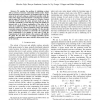Free Online Productivity Tools
i2Speak
i2Symbol
i2OCR
iTex2Img
iWeb2Print
iWeb2Shot
i2Type
iPdf2Split
iPdf2Merge
i2Bopomofo
i2Arabic
i2Style
i2Image
i2PDF
iLatex2Rtf
Sci2ools
CDC
2010
IEEE
2010
IEEE
The Wireless Control Network: Synthesis and robustness
We consider the problem of stabilizing a plant with a network of resource constrained wireless nodes. Traditional networked control schemes are designed with one of the nodes in the network acting as a dedicated controller, while the other nodes simply route information to and from the controller and the plant. We introduce the concept of a Wireless Control Network (WCN) where the entire network itself acts as the controller. Specifically, at each time-step, each node updates its internal state to be a linear combination of the states of the nodes in its neighborhood. We show that this causes the entire network to behave as a linear dynamical system, with sparsity constraints imposed by the network topology. We then provide a numerical design procedure to determine the appropriate linear combinations to be applied by each node so that the transmissions of the nodes closest to the actuators will stabilize the plant. We also show how our design procedure can be modified to maintain mean ...
| Added | 13 May 2011 |
| Updated | 13 May 2011 |
| Type | Journal |
| Year | 2010 |
| Where | CDC |
| Authors | Miroslav Pajic, Shreyas Sundaram, Jerome Le Ny, George J. Pappas, Rahul Mangharam |
Comments (0)

